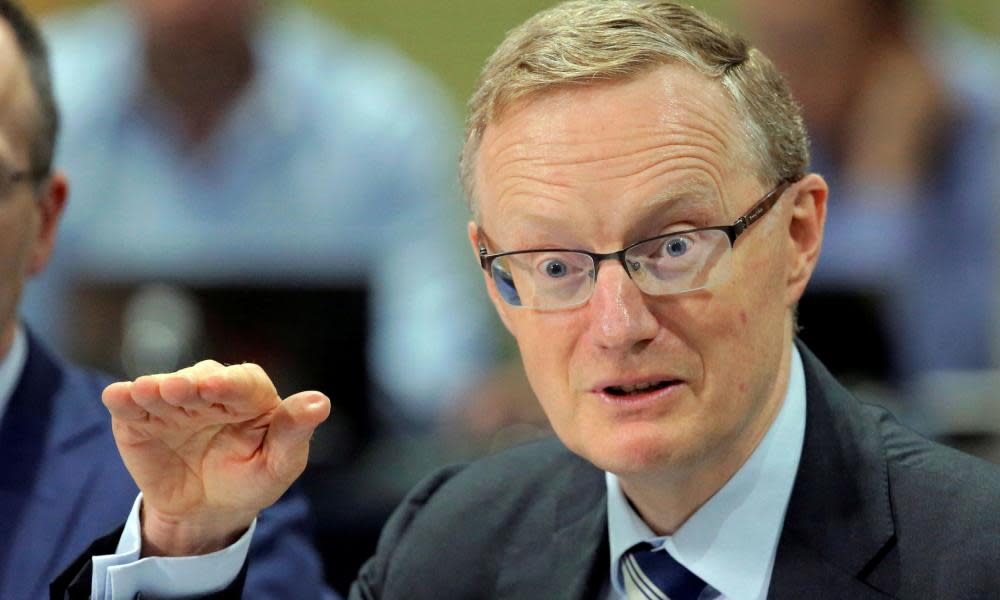Things have changed in Australia. But the interest rate is unlikely to for some time

On Tuesday afternoon the Reserve Bank board will meet to decide monetary policy. It will almost certainly not increase the cash rate – thus extending the run without an increase to nearly 11 years.
Nothing has changed more in my life than what has become considered normal for interest rates.
When I was born, had my parents wanted to take out a home loan, they would have paid about 7% interest on their mortgage. This would have been considered quite outrageous compared with the below 6% rates that Australians had been used to until the early 1970s.
Related: Should Australia increase interest rates to stop house prices rising so quickly? | Chris Edmond
By the time I began high school in the early 1980s, the official interest rate was over 10%, and during the 80s recession under treasurer John Howard it reached a record 20.8%.
Throughout the 80s you were likely to be paying a mortgage rate about 13% or 14%.
When I left university with my shiny economics degree in 1993, the cash rate was 4.75%, and we had broken the back of inflation (thanks to standard variable rates rising to 17% and utterly crippling the economy):
Click here if you cannot view the graph
From then on the cash rate never went above 7.5%, and when it hit 4.25% in 2002 Howard, to his later regret, boasted of record-low interest rates.
During the mining boom, rising interest rates became the number one economic issue. In 2004, the Liberal party used them to scare people about voting for Labor, and in 2007 Labor used them to argue the Liberal party had failed to manage the economy.
Essentially my life at that point consisted of a first half of high interest rates that were taken as given, then a second half of thinking a cash rate around 5% was reasonable but any rise in rates meant the government was failing and the economy was overheating.
Then along came the GFC and utterly destroyed all that conventional wisdom.
The cash rate was cut to a then record low 3% and in the decade long period of economic mediocrity afterwards rising interest rates became but a memory.
Back in November 2010, Ke$ha was banging out “We R Who We R” and moviegoers were watching a new film that showed Mark Zuckerberg as a weird kid who started Facebook mostly to be cool.
It was also the last time the Reserve Bank raised the cash rate.
That’s 128 months since the last interest rate rise (and later on Tuesday, it will be 129 months).
The longest time between rate rises before this period was the 58 months between December 1994 and November 1999.
The difference then, however, was the RBA stopped raising rates at 7.5% and the cash rate only fell to 4.75% – a drop of 275 basis points or a bit over a third of what the rate had been.
In November 2010 when the RBA last raised the cash rate it was up to 4.75% and it is now at 0.1% – a 465 basis points drop, or about 98% below what it had been:
Click here if you cannot view the graph
Things have changed. But the interest rate is unlikely to for some time.
The governor of the Reserve Bank, Philip Lowe, has stated the bank “will not increase the cash rate until actual inflation is sustainably within the 2% to 3% target range”.
And yet last week the latest CPI figures showed inflation grew by 3.8% – well above the target range and the fastest since September 2008.
So why is there absolutely no expectation the RBA will increase rates on Tuesday?
While the RBA does look at CPI, it cares more about underlying or core inflation – inflation that removes the more erratic aspects of CPI. And right now there are a lot of those:
Click here if you cannot view the graph
Despite CPI hitting 3.8%, the RBA’s core measure, the “trimmed mean” only rose to 1.6% – not even close to 2%-3%, let alone “sustainably within”.
One big driver of the CPI was petrol prices – up 6.2% in the June quarter alone and 27% in the past year:
Click here if you cannot view the graph
That is the fastest petrol prices have risen in a 12-month period since 1990, and yet all it really is is a recovery from the fall during the pandemic. Prices are only a touch under 3% higher than they were before the pandemic.
So we remain very much in the wash of Covid, and it is far too soon – especially with the current lockdowns – to have much confidence about what the future holds.
The RBA will also note that market inflation expectations remain well below 2%:
Click here if you cannot view the graph
So we are likely to be still many months away from an interest rate rise.
What will be interesting when it finally does happen is how the public that has become so used to rates staying flat or falling will cope, and whether we will realise it is actually a good sign, and not – as we did in the past – think it is something to be afraid of.

 Yahoo Movies
Yahoo Movies 
